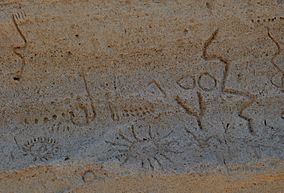Petroglyph Point Archeological Site facts for kids
Quick facts for kids Petroglyph Point Archeological Site |
|
|---|---|
|
IUCN Category III (Natural Monument)
|
|
 |
|
| Location | Siskiyou County, California, USA |
| Nearest city | Tule Lake |
| Area | 1,600 |
| Established | May 29, 1975 |
| Governing body | National Park Service |
| Designated: | 1975 |
| Reference #: | 75000178 |
Petroglyph Point is a special place in California. It is found inside the Lava Beds National Monument, near Tule Lake. This site is an archaeological site, which means it is a place where people study old human history.
Petroglyph Point is famous for having one of the biggest collections of rock art in the United States. This art was made by Native American people. These amazing carvings, called petroglyphs, are found on the side of what used to be an island. This island was once part of an old lake called Tule Lake. The area was historically the home of the Modoc people.
The Petroglyph Point Archeological Site was added to the National Register of Historic Places in 1975. This list helps protect important historical places. The larger area, the Lava Beds National Monument Archeological District, was added to the list in 1991.
Understanding the Petroglyphs
It is hard to figure out exactly how old the petroglyphs are. This is because Tule Lake's water level changed a lot over time. The carvings may have been covered by water many times. This makes it difficult to use weather damage to guess their age. Most experts believe these carvings were made between 2,000 and 6,000 years ago.
What the Art Looks Like
The rock art at Petroglyph Point is different from art found in other parts of the western United States. Many of the images here are mostly geometric patterns. This means they are shapes and lines, not pictures of people or animals.
Why We Don't Know Their Meaning
Sadly, we do not know the exact meaning of these petroglyphs. After the Modoc War, many Native Americans from this region moved away. Because of this, no one was able to study the Modoc people to record what the symbols meant.


